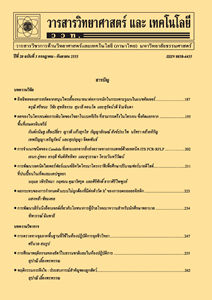การศึกษารูปแบบการไหลเวียนกระแสน้ำในอ่าวไทยในปีภาวะเอ็นโซ่
Main Article Content
Abstract
บทคัดย่อ
การวิจัยในครั้งนี้เป็นการศึกษาถึงรูปแบบการไหลเวียนกระแสน้ำในอ่าวไทยภายใต้ภาวะเอ็นโซ่ การไหลเวียนของกระแสน้ำในอ่าวได้จากแบบจำลองกระแสน้ำ POM (Princeton Ocean Model) โดยมีข้อมูลนำเข้าคือ ข้อมูลลม ข้อมูลอุณหภูมิและความเค็มผิวน้ำทะเล ซึ่งผลของกระแสน้ำเฉลี่ยรายเดือนได้ถูกนำมาเปรียบเทียบกับข้อมูลกระแสน้ำที่ได้จากทุ่นสมุทรศาสตร์ ณ สถานีระยอง และเพชรบุรี ซึ่งความสัมพันธ์ของกระแสน้ำที่ได้จากแบบจำลองกระแสน้ำโดยเทียบกับทุ่นสมุทรศาสตร์มีค่าความสัมพันธ์ถึง 50-60% ดังนั้นสามารถนำแบบจำลองมาใช้ในการทำนายถึงรูปแบบการไหลเวียนกระแสน้ำในอ่าวไทยได้ รูปแบบกระแสน้ำที่ถูกขับเคลื่อนโดยลมในอ่าวไทยในช่วงปีภาวะเอลนินโญ่ (พ.ศ. 2540-2541) และปีภาวะลานินญ่า (พ.ศ. 2541-2542) มีรูปแบบคล้ายคลึงกันกับในปีภาวะปกติ (พ.ศ. 2546) นอกจากว่ากระแสน้ำมีความแรงมากในช่วงปีภาวะเอลนินโญ่และ ลานินญ่า สำหรับในช่วงฤดูร้อน (เดือนเมษายน) กระแสน้ำจะมีลักษณะวงวนแบบทวนเข็มนาฬิกาและไหลออกจากอ่าว ในช่วงฤดูมรสุมตะวันตกเฉียงใต้ (เดือนสิงหาคม) กระแสน้ำมีรูปแบบการไหลออกจากอ่าวทางด้านตะวันตกของอ่าวและกระแสน้ำมีทิศทางไหลเข้าอ่าวทางด้านตะวันออกของอ่าวและมีลักษณะเป็นวงวนในทิศทวนเข็มนาฬิกาในบริเวณแหลมคาเมา ส่วนในเดือนตุลาคมกระแสน้ำเริ่มมีการเปลี่ยนทิศทาง และในช่วงมรสุมตะวันออกเฉียงเหนือ (เดือนมกราคม) กระแสน้ำมีลักษณะเวียนจากทางด้านตะวันออกของอ่าวและไหลเลียบขึ้นไปทางชายฝั่งตะวันตกของอ่าวไทย
คำสำคัญ : การไหลเวียนกระแสน้ำ; อ่าวไทย; เอ็นโซ่
Abstract
The aim of this research is to study circulation patterns in the Gulf of Thailand under different ENSO conditions. The circulation in the gulf was derived from POM (Princeton Ocean Model). Inputs to the model were wind data, sea surface temperature and salinity data. The monthly averages of currents were compared with measured current data from the offshore oceanographic buoys at Rayong and Petchburi station. The model predicted and the measured current were comparable with 50-60% correlation. Thus, the POM model could be used to predict the circulation patterns in the Gulf of Thailand. Wind-driven circulation patterns in the gulf during El Nino years (1997-1998) and La Nina years (1998-1999) were similar to that during the moderate year (2003) except that the current speeds were much stronger during the El Nino and La Nina years. During summer (April), counter-clock wise circulation existed in the gulf. During the South West monsoon (August), water flowed out of the gulf via the western side. Then the currents turned to the eastern side of the gulf, the counter-clock wise eddy existed at the tip of Ca Mau peninsular. In October, the currents started to switch direction and during the North East monsoon (January), the current meander from the eastern side of the gulf entrance to the western side, then flowed along the gulf’s western coast into the gulf.
Keywords: circulation; Gulf of Thailand; ENSO


